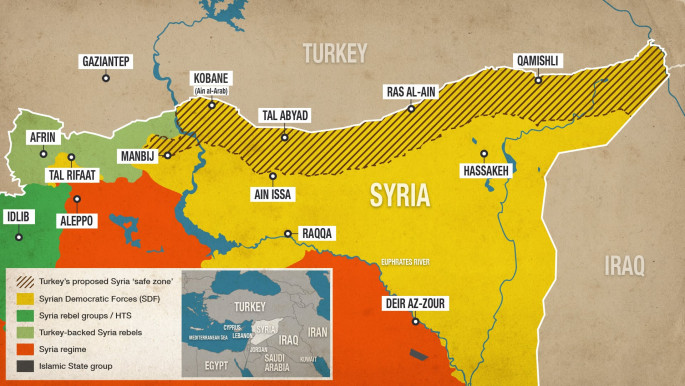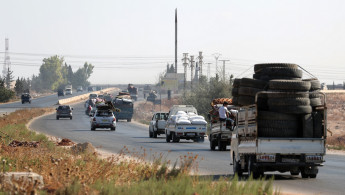Follow us on Twitter: @The_NewArab
Some Syrians are fleeing Turkey's offensive, others are returning home
This is despite the assurances of the Turkey-backed Syrian National Army (SNA) that fighters would not commit abuses against civilians and that the aim of the military operation is to expel the Syrian Democratic Forces (SDF) - dominated by Kurdish forces - from northern Syria.
The SNA and the Turkish army took control of Tal Abyad on Sunday, as part of the military operation against the SDF, but the campaign has led to mass displacement.
"People are displaced and are moving to the areas of Raqqa countryside," media activist Wissam al-Arabi told The New Arab.
"The internally displaced depend on relatives because of the clan dimension, and most of them manage this way at the moment. As for the numbers of displaced people there is no accurate estimates," he said.
"Whoever owns a car managed to transport some valuable and belongings."
The Kurdish Red Crescent has confirmed that the number of displaced from the border areas with Turkey east of the Euphrates reached nearly 200,000 people, while aid groups have warned that up to 450,000 could be uprooted in the fighting.
Al-Arabi stressed the need for basic services, especially water, which has been cut off from the Hasakeh area for days because of the failure of a pumping station in the town of Alouk, east of Ras al-Ayn.
Syrians hope to return
Syrians who were previously displaced by SDF forces who took over Arab towns - such as Tal Abyad - during the fight against the Islamic State group.
Syrians from these areas are hoping they may be able to return home after the SNA took over.
"Since the SDF militia took control of the Tal Abyad area, I had to leave my house. Now my wife and I live in the city of al-Bab in Aleppo countryside," Abu Ahmed, 43, told The New Arab.
 |
These refugees were displaced from Tal Abyad by the Kurdish People's Protection Units (YPG) militia, which is the key component of the SDF.
Awad al-Sultan, who fled to Turkey during the YPG militia's takeover of of Tal Ayad is relieved that the Turkish-backed SNA have taken the town, with rebels having controlled it before IS.
"We waited a long time for our land was liberated, and now we will return," he said.
Awwad served as a director of the Syrian Red Crescent branch in Tal Abyad, before fleeing to Turkey two years ago.
He reiterated the determination of those displaced from areas held by Kurdish forces to return to their land after it is "liberated from the SDF militias".
Turkey has promised to build a "safe zone" in areas it captures from the SDF, with Awwad saying that the northern Syrian region is economically important and was previously a place many Syrians headed to for work.
|
|
According to the Office of Internally Displaced Peoples Affairs of the autonomous regions, the number of displaced people as a result of the latest incursion reached 191,000 on Sunday.
The statement said there has been a lack of a humanitarian response from international organisations after they were forced to withdraw staff and halt activities in the region.
Idlib
Meanwhile, people in Idlib province, northwestern Syria, are concerned about the prospect of a renewed regime military escalation on the opposition area, a month-and-a-half after a truce was declared by Russia.
Over the past two days, Russian warplanes bombarded several cities and towns in the southern countryside of Idlib, renewing fears of possible displacement, after a number of residents recently returned.
Some, such as Ahmad al-Khatib, a resident of Kafr Takharim in the northwestern Idlib countryside, told The New Arab on Monday that he is considering returning to the town due to the increased hardships of winter and financial reasons.
Despite the hardships, others do not wish to return to life under Russian bombardment.
While the displaced from the town of Kafr Sijneh Mustafa Mohammed, said that the shelling and dire living conditions in the town, would not convince him to return.
"I lost everything, my house was damaged by the shelling, and I want to keep my children, so I prefer to remain displaced," he said.
"No matter how hard it is, it is too easy for them to be injured during the shelling."
The director of the team of Syrian first responders, Mohammed Hallaj, said many are concerned and skepticism around the truce, similar to the previous truces announced by Russia or the Syrian regime.
"The same method is repeated again and again. Reconnaissance planes do not leave the sky, and then begin targeted air strikes, before this becomes aerial bombing campaigns. This is what we saw in previous military campaigns."
According to a report by the team, the regime forces targeted the area with 58 air strikes during the last week.
Since the "safe zone agreement" was signed in Sochi last September, over 100,000 have been displaced from the area, while 87,000 have returned to areas of southern Idlib countryside.





 Follow the Middle East's top stories in English at The New Arab on Google News
Follow the Middle East's top stories in English at The New Arab on Google News


